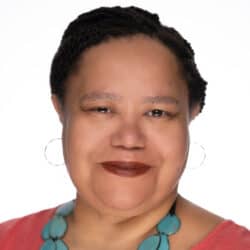Are you hiring a new executive director, or are you a new ED yourself? These three new-ish executive directors talk candidly about their experiences and share some practical advice for supporting a new person in this role.
With non-profits experiencing increased turnover in the past few years and more leadership changes on the horizon as leaders retire, there are more new executive directors navigating this complex role.
“Executive director” is the most common title for the senior leader of a non-profit organization. The role looks different in every organization: it might be the only paid staff position for a small non-profit, or the ED might oversee a large team with several departments. They typically oversee the day-to-day operations of an organization and report to a volunteer board of directors. At the same time that new people are entering this role, some organizations are questioning the status quo and distributing leadership, exploring co-leadership, and reimagining governance to expand the ways organizations work together and make decisions.
Leadership changes are inevitable, so we asked three new executive directors to share their experience and advice on how to support a new ED in their role. New EDs and board members, take note of each leader’s tip sheet!
Engage the outgoing leader for a smooth transition
—Sahar Vermezyari, director, East Scarborough Storefront, Toronto

Sahar Vermezyari became the director of the East Scarborough Storefront, a community development organization in the Kingston-Galloway/Orton Park neighbourhood and a project on the MakeWay shared platform, in the summer of 2021. Vermezyari had worked in a staff role from 2008 to 2013 and came back to fill the position that the former director, Anne Gloger, had been in for 20 years.
To support the transition, Gloger stayed on for the first two months that Vermezyari was in her new role and designed a “learning journey” to introduce Vermezyari to Storefront’s philosophy and the role it plays in the community. The journey included a storytelling workshop with Storefront’s community partners and residents about their projects’ origins and purpose to ensure that the information that Gloger had been holding over the past 20 years was passed along. On top of sharing logistical information, “there were lots of conversations about how I was feeling in the role,” Vermezyari says. These talks helped to normalize the challenges of a leadership role. When there were challenges, Vermezyari could talk with Gloger to understand “it wasn’t a ‘me thing’ but ‘that’s systemic’ or ‘that’s just part of the ED role.’” It helped give Vermezyari perspective.
When there were challenges, Vermezyari could talk with [the previous ED] to understand ‘it wasn’t a “me thing” but “that’s systemic” or “that’s just part of the ED role.”’
Stepping into the shoes of someone who has been well respected in their role and community can be daunting, Vermezyari says. You want to live up to the expectations while also finding the space to be you. “At the beginning, I felt like I had to be Anne,” Vermezyari says. “After a while, you come into your own,” but it took time, communication, confidence, and support, she adds.
Vermezyari says that this collaborative approach to the leadership transition worked in large part because of her strong relationship with Gloger and the trust they had in each other, but she thinks it can work even for those who don’t know each other when they start the transition. She says there are necessary ingredients to make it work: shared, unconditional commitment to the success of the transition, putting egos aside, humility, and a willingness to share the struggles of the role and give permission to be open with one another.
Vermezyari has two additional tips for new EDs:
- Set up regular check-ins with people (non-profit friends, colleagues) who know you and are rooting for you in the sector – they can be a sounding board as you navigate the new role.
- Disburse responsibility where you can – there is an immense responsibility that comes with the role that can feel overwhelming. Share it with others where it makes sense.
Ask the board good questions before making the leap
—Tyler Colbourne, executive director, Healthy Minds Cooperative, Halifax

When Tyler Colbourne saw the posting for an executive director of a mental health co-operative in Nova Scotia in late 2021, he knew it could be a meaningful position but also a big job to take on. Following the challenges of the pandemic, Colbourne wanted to make sure the role was the right fit. “I asked some really hard questions to the board.”
Colbourne had noticed in previous roles that boards don’t always know the realities an organization is facing, and he wanted to make sure he had a good understanding of the organization and the context he would be stepping into. He asked about the board’s relationship with staff, asked to see the bylaws and policies, wanted a clear picture of the finances and where the organization was in its journey and commitment to put equity, diversity, and inclusion into practice.
Colbourne wanted to make sure he had a good understanding of the organization and the context he would be stepping into.
Even with that preparation, there were some surprises, but the board, staff, and Colbourne were able to work together to tackle them, including calling and informing 400 members in a short period of time about a special members’ meeting to make time-sensitive updates to the bylaws.
The first year was intense, but Colbourne wants us to resist the notion that the struggles and juggle of ED life have to be that way. “Acknowledge but don’t accept it,” he says.
Colbourne shares some of the lessons he’s learned over the past year:
- Overlap your time as much as possible with the previous ED so there is time to ask questions and understand the current situation.
- “Humility across all levels.” The transition to a new ED will bring up lots of questions and issues to address. Get power and ego out of the way and learn together as an organization.
- Make time for your peers. “Being an ED can be isolating,” Colbourne explains. It’s unfair to unload your worries on staff, so you need to find other places for support. He says a standing monthly meeting with fellow EDs and leaders continues to support him in his role. As things get busy, “it’s easy to let it fall by the wayside,” but don’t! Intentionally carving out time will benefit you.
- Relationship-building is essential. Make time for the board and staff to get to know each other. “We had a lot of conversations around power really early on,” Colbourne says. “We learned together rather than from positions of power.”
- Go slower. “I wish I said no to more opportunities,” Colbourne says, reflecting on his first year in the role. It’s easy to feel the pull to prove yourself and bring new opportunities to the organization, but consider your own and your organization’s capacity.
- Encourage the board chair to support, reward, and recognize the board so the ED can focus on other priorities. “So much ED time can be spent managing up.”
A supportive board is on the same page
—Raine Liliefeldt, director of member services and development and former interim CEO, YWCA Canada

Raine Liliefeldt comes to this topic with her own experience as former interim CEO for YWCA Canada and also as a leader in an organization that supports 30 YWCA organizations across Canada. Of those 30 organizations, 18 have CEOs or EDs that have started their role since 2020.
Liliefeldt has seen a range of boards help and hinder a new executive director. “Board members are volunteers – they’re committed and driven,” she explains. In some cases, however, organizations have “almost lost amazing leaders because of ineffective board leadership.” Many have had to step into operations in the last three years of the pandemic, and it can be hard to step back. Liliefeldt has seen boards that are really supportive, while others let the ED figure everything out for themselves.
In some cases, organizations have ‘almost lost amazing leaders because of ineffective board leadership.’
To help a new ED, boards need to get on the same page, she says. “True consensus and speaking with one voice is beautiful.” This doesn’t mean the board members always agree, but they’ve discussed their interests together so they are clear on their priorities and focus. When the board hasn’t discussed topics before talking with the ED or other staff, it can feel like “question karate,” where comments come at staff from various directions. Liliefeldt suggests meeting as a board to ensure that questions and comments are aligned.
Liliefeldt has advice for boards that are recruiting a new ED:
- Get on the same page about who you are looking for and what you need in a new ED.
- Think beyond recruitment. Make a plan for how the ED will be supported in their first year.
- Focus less on probation and more on support. Be mindful that Black, Indigenous, and racialized leaders face greater scrutiny when they actually need support.
- Ego needs to get out of the way. Boards want to look good, and saviour complexes “run ripe in the sector,” Liliefeldt explains. “Give space for EDs to lead.”
- Be honest in the interview process. What are the hot-button issues going into the job? How does the board function? Just as importantly, what are the exciting parts of the role? “Be clear on where the joys are,” she says.
We know that every board and ED will have their own experience and advice on this topic. What would you add? Share on social media or write to us at info@thephilanthropist.ca. We will share a collection of reader responses in our newsletter and social media channels.
The Work in Progress series is being developed in collaboration with the following content development partners: the Future Skills Centre, the Counselling Foundation of Canada, CERIC, Imagine Canada, the Ontario Nonprofit Network, and the Workforce Funder Collaborative.


